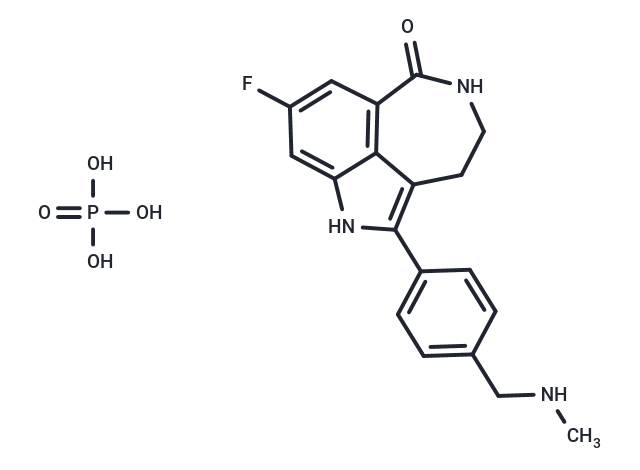Shopping Cart
- Remove All
 Your shopping cart is currently empty
Your shopping cart is currently empty

Rucaparib Phosphate (PF-01367338 phosphate) is an inhibitor of PARP (Ki: 1.4 nM for PARP1) that is used in clinical therapy to sensitize cancer cells to chemotherapy.

| Pack Size | Price | Availability | Quantity |
|---|---|---|---|
| 1 mg | $32 | In Stock | |
| 2 mg | $45 | In Stock | |
| 5 mg | $72 | In Stock | |
| 10 mg | $117 | In Stock | |
| 25 mg | $198 | In Stock | |
| 50 mg | $261 | In Stock | |
| 100 mg | $413 | In Stock | |
| 200 mg | $615 | In Stock | |
| 1 mL x 10 mM (in DMSO) | $72 | In Stock |
| Description | Rucaparib Phosphate (PF-01367338 phosphate) is an inhibitor of PARP (Ki: 1.4 nM for PARP1) that is used in clinical therapy to sensitize cancer cells to chemotherapy. |
| Targets&IC50 | PARP:1.4 nM (Ki, cell free) |
| In vitro | AG14447 (the phosphate salt of Rucaparib) is the most potent PARP inhibitor in enzyme assays (Ki: 1.4 nmol/L) [1]. In permeabilised D283Med cells, Rucaparib (AG-014699), at concentrations of 0.1, 0.4 and 1?μ inhibited PARP-1 activity by 81.1, 96.8 and 97.1%, respectively [2]. AG014699 (≤10 μM) was cytotoxic to cells with mutated BRCA1/2 or XRCC3 and to UACC3199 cells with epigenetically silenced BRCA1 but not to cells without BRCA1/2 or XRCC3 mutations or that were heterozygous for BRCA2 mutation [3]. |
| In vivo | When 10 mg/kg Rucaparib was administered in combination with temozolomide, body weight loss was observed at days 4 to 13 posttreatment with the nadir body weight ranging from 83% to 96% of the starting weight. At a dose of 1 mg/kg, Rucaparib also significantly increased temozolomide-induced body weight loss [1]. At 1mg/kg daily five times, AG-014699 alone did not cause any marked toxicity or affect tumour growth compared with vehicle-only controls. Co-administration of AG-014699 with temozolomide also resulted in complete tumour regressions in all mice, of which three out of five were sustained throughout the experiment. The MMR-defective D283Med xenografts grew very rapidly and showed very little response to temozolomide alone (TGD of only 2 days) with no regressions observed in any mice [2]. |
| Kinase Assay | We measured inhibition of human full-length recombinant PARP-1 by [32P]NAD+ incorporation as described previously. The [32P]ADP-ribose incorporated into acid insoluble material was quantified using a PhosphorImager. Kis were calculated by nonlinear regression analysis [1]. |
| Cell Research | Inhibition of PARP activity in 5000 exponentially growing D283Med cells was measured following treatment with a range of AG-014699 concentrations (0–1?μ), in comparison with DMSO-only controls. Maximally stimulated PARP activity was measured in replicate samples (n?3) of permeabilised cells by immunological detection of the amount of poly(ADP-ribose) (PAR) formed, using 10H anti-PAR antibody, during a 6-min incubation with NAD+ and oligonucleotide (substrate and activator) by reference to a PAR standard curve using a GCLP-validated assay described previously [2]. |
| Animal Research | One or four daily doses of PARP inhibitor AG-014699 (1?mg/kg intraperitoneally (i.p.)) were given to CD-1 nude mice bearing established D283Med xenografts. At 0.5, 2, 6 and 24?h after the initial or fourth daily dose of AG-014699, three animals per time point were bled by cardiac puncture under general anaesthesia, and then killed. Plasma was separated from the blood samples using standard methods and stored at ?80°C. The brains and tumours were removed, snap frozen in liquid nitrogen and stored at ?80°C before analysis. Blood, tumour and brain tissue were removed from three untreated control animals and processed in the same way [2]. |
| Alias | PF-01367338 phosphate, AG-014699 phosphate |
| Molecular Weight | 421.36 |
| Formula | C19H18FN3O·H3PO4 |
| Cas No. | 459868-92-9 |
| Smiles | OP(O)(O)=O.CNCc1ccc(cc1)-c1[nH]c2cc(F)cc3C(=O)NCCc1c23 |
| Relative Density. | no data available |
| Storage | Powder: -20°C for 3 years | In solvent: -80°C for 1 year | Shipping with blue ice. | |||||||||||||||||||||||||||||||||||
| Solubility Information | Ethanol: < 1 mg/mL (insoluble or slightly soluble) H2O: < 1 mg/mL (insoluble or slightly soluble) DMSO: 78 mg/mL (185.11 mM), Sonication is recommended. | |||||||||||||||||||||||||||||||||||
Solution Preparation Table | ||||||||||||||||||||||||||||||||||||
DMSO
| ||||||||||||||||||||||||||||||||||||

Copyright © 2015-2025 TargetMol Chemicals Inc. All Rights Reserved.